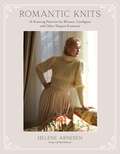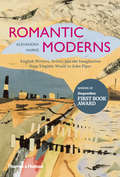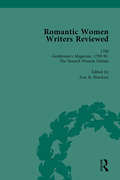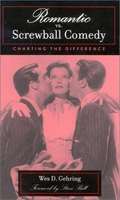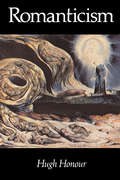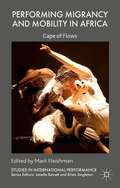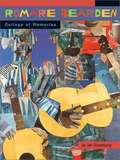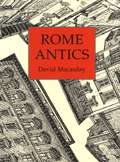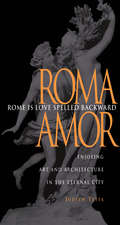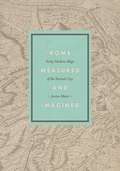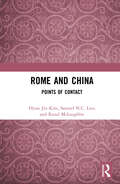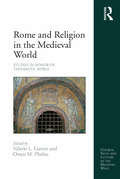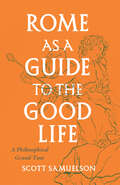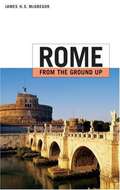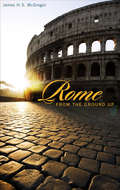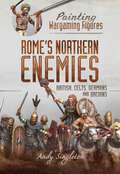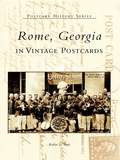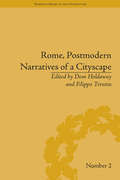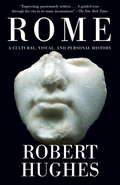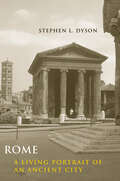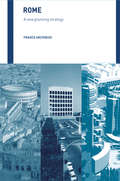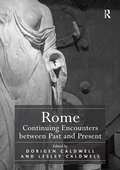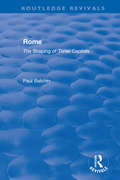- Table View
- List View
Romantic Knits: 16 Knitting Patterns for Blouses, Cardigans and Other Elegant Knitwear
by Helene ArnesenFill your wardrobe with breathtaking handmade pieces that you will treasure for years to come. Knitwear designer Helene Arnesen is a master in combining simple knitting techniques with elegant details, such as billowing sleeves, ribbon ties and lace edging, to capture the romantic essence of vintage fashion. More than just a collection of practical patterns, this thoughtfully and artistically crafted book will evoke inspiration and delight with each turn of the page. With Helene, a world of beautiful feminine charm is only a knit purl away.
Romantic Moderns: English Writers, Artists and the Imagination from Virginia Woolf to John Piper
by Alexandra HarrisWinner of the 2010 Guardian First Book Award: a groundbreaking reassessment of English cultural life in the thirties and forties. In the 1930s and 1940s, while the battles for modern art and modern society were being fought in Paris and Spain, it seemed to some a betrayal that John Betjeman and John Piper were in love with a provincial world of old churches and tea shops. Alexandra Harris tells a different story: eclectically, passionately, wittily, urgently, English artists were exploring what it meant to be alive at that moment and in England. They showed that "the modern" need not be at war with the past: constructivists and conservatives could work together, and even the Bauhaus émigré László Moholy-Nagy was beguiled into taking photos for Betjeman's nostalgic An Oxford University Chest. A rich network of personal and cultural encounters was the backdrop for a modern English renaissance. This great imaginative project was shared by writers, painters, gardeners, architects, critics, and composers. Piper abandoned purist abstracts to make collages on the blustery coast; Virginia Woolf wrote in her last novel about a village pageant on a showery summer day. Evelyn Waugh, Elizabeth Bowen, and the Sitwells are also part of the story, along with Bill Brandt and Graham Sutherland, Eric Ravilious and Cecil Beaton.
Romantic Women Writers Reviewed, Part I Vol 3
by Ann R Hawkins Stephanie EckrothThis multi-volume reset collection will addresses significant shortfall in scholarly work, offering contemporary reviews of the work of Romantic women writers to a wider audience.
Romantic vs. Screwball Comedy: Charting the Difference
by Wes D. JehringThis examination of film comedies distinguishes the elements which separate the screwball comedy from the romantic comedy. A great resource for film scholars, movie fans, and writers.
Romanticism (Icon Editions)
by Hugh HonourA study of the influence Romanticism exerts upon Western culture.
Romanticism and the Museum: Cape Of Flows (Studies In International Performance Ser.)
by Emma PeacockePerforming Migrancy and Mobility in Africa focuses on a body of performance work, the work of Magnet Theatre in particular but also work by other artists in Cape Town and other parts of the continent or the world, that engages with the Cape as a real or imagined node in a complex system of migration and mobility. Located at the foot of the African continent, lodged between two oceans at the intersection of many of the earth's major shipping lanes, Cape Town is a stage for a powerful mixing of cultures and peoples and has been an important node in a network of flows, circuits of movement and exchange. The performance works studied here attempt to get to grips with what it feels like to be on the move and in the spaces in-between that characterises the lives, now and for centuries before, of multiple peoples who move around and pass through places like the Cape. The contributors are a broad range of mostly African authors from various parts of the continent and as such the book offers an insight into new thinking and new approaches from an emerging and important location.
Romare Bearden: Collage of Memories
by Jan GreenbergRecounts the life of the twentieth-century African-American collage artist who used his southern childhood. New York City, jazz, and Paris to influence his bold and meaningful art.
Rome
by Spiro Kostof Rabun Taylor Rinne Katherine WentworthSpanning the entire history of the city of Rome from Iron Age village to modern metropolis, this is the first book to take the long view of the Eternal City as an urban organism. Three thousand years old and counting, Rome has thrived almost from the start on self-reference, supplementing the everyday concerns of urban management and planning by projecting its own past onto the city of the moment. This is a study of the urban processes by which Rome's people and leaders, both as custodians of its illustrious past and as agents of its expansive power, have shaped and conditioned its urban fabric by manipulating geography and organizing space; planning infrastructure; designing and presiding over mythmaking, ritual, and stagecraft; controlling resident and transient populations; and exploiting Rome's standing as a seat of global power and a religious capital.
Rome Antics
by David MacaulayA pigeon carrying an important message takes the reader on a unique tour through Rome. As we follow the path of this somewhat wayward bird, we discover that Rome is a place where past and present live side by side. Every time a corner is turned there is a surprise, just as every turn of the page brings a new perspective. This juxtaposition of ancient and modern, as seen with David Macaulay's ingenious vision, gives the reader an imaginative and informative journey through this wondrous city.
Rome Is Love Spelled Backward: Enjoying Art and Architecture in the Eternal City
by Judith TestaA celebration of the art, architecture, and timeless human passion of the Eternal City, Rome Is Love Spelled Backward explores Rome's best-known treasures, often revealing secrets overlooked in conventional guidebooks. With the ancient play on "Roma" and "Amor"—ROMAMOR—Testa invites readers to experience the world's long love affair with one of its most beautiful cities.
Rome Measured and Imagined: Early Modern Maps of the Eternal City
by Jessica MaierAt the turn of the fifteenth century, Rome was in the midst of a dramatic transformation from what the fourteenth-century poet Petrarch had termed a “crumbling city” populated by “broken ruins” into a prosperous Christian capital. Scholars, artists, architects, and engineers fascinated by Rome were spurred to develop new graphic modes for depicting the city—and the genre known as the city portrait exploded. In Rome Measured and Imagined, Jessica Maier explores the history of this genre—which merged the accuracy of scientific endeavor with the imaginative aspects of art—during the rise of Renaissance print culture. Through an exploration of works dating from the fifteenth to the eighteenth centuries, her book interweaves the story of the city portrait with that of Rome itself. Highly interdisciplinary and beautifully illustrated with nearly one hundred city portraits, Rome Measured and Imagined advances the scholarship on Renaissance Rome and print culture in fascinating ways.
Rome and China: Points of Contact
by Hyun Jin Kim Raoul McLaughlin Samuel N.C. LieuRome and China provides an updated history and analysis of contacts and mutual influence between two of ancient Eurasia’s most prominent imperial powers, Rome and China. It highlights the extraordinary interconnectivity of ancient Eurasia which allowed for actual contacts between Rome and China (however fleeting) and examines in detail the influences from both ends of Eurasia which had cultural and political consequences for both Rome and China. This volume will be of interest to anyone working on the Roman Empire, Inner Asia, the Silk Routes and China in the Classical and Late Antique periods.
Rome and Religion in the Medieval World: Studies in Honor of Thomas F.X. Noble (Church, Faith and Culture in the Medieval West)
by Valerie L. Garver Owen M. PhelanRome and Religion in the Medieval World provides a panoramic and interdisciplinary exploration of Rome and religious culture. The studies build upon or engage Thomas F.X. Noble’s interest in Rome, especially his landmark contributions to the origins of the Papal States and early medieval image controversies. Scholars from a variety of disciplines offer new viewpoints on key issues and questions relating to medieval religious, cultural and intellectual history. Each study explores different dimensions of Rome and religion, including medieval art, theology, material culture, politics, education, law, and religious practice. Drawing upon a wide range of sources, including manuscripts, relics, historical and normative texts, theological tracts, and poetry, the authors illuminate the complexities of medieval Christianity, especially as practiced in the city of Rome itself, and elsewhere in Europe when influenced by the idea of Rome. Some trace early medieval legacies to the early modern period when Protestant and Catholic theologians used early medieval religious texts to define and debate forms of Roman Christianity. The essays highlight and deepen scholarly appreciation of Rome in the rich and varied religious culture of the medieval world.
Rome and the Legacy of Louis I. Kahn (Routledge Research in Architecture)
by Elisabetta Barizza Marco FalsettiLouis I. Kahn was one of the most influential architects, thinkers and teachers of his time. This book examines the important relationship between his work and the city of Rome, whose ancient ruins inspired in him a new design methodology. Structured into two main parts, the first includes personal essays and contributions from the architect’s children, writers and other designers on the experience and impact of his work. The second part takes a detailed look at Kahn’s residency in Rome, its effects on his thinking, and how his influence spread throughout Italy. It analyses themes directly linked to his architecture, through interviews with teachers and designers such as Franco Purini, Paolo Portoghesi, Giorgio Ciucci, Lucio Valerio Barbera and the architects of the Rome Group of Architects and City Planners (GRAU). Rome and the Legacy of Louis I. Kahn expands the current discourse on this celebrated twentieth-century architect, ideal for students and researchers interested in Kahn’s work, architectural history, theory and criticism.
Rome as a Guide to the Good Life: A Philosophical Grand Tour
by Scott SamuelsonA unique, portable guidebook that sketches Rome’s great philosophical tradition while also providing an engaging travel companion to the city. This is a guidebook to Rome for those interested in both la dolce vita and what the ancient Romans called the vita beata—the good life. Philosopher Scott Samuelson offers a thinker’s tour of the Eternal City, rooting ideas from this philosophical tradition within the geography of the city itself. As he introduces the city’s great works of art and its most famous sites—the Colosseum, the Forum, the Campo de’ Fiori—Samuelson also gets to the heart of the knotty ethical and emotional questions they pose. Practicing philosophy in place, Rome as a Guide to the Good Life tackles the profound questions that most tours of Rome only bracket. What does all this history tell us about who we are? In addition to being a thoughtful philosophical companion, Samuelson is also a memorable tour guide, taking us on plenty of detours and pausing to linger over an afternoon Negroni, sample four classic Roman pastas, or explore the city’s best hidden gems. With Samuelson’s help, we understand why Rome has inspired philosophers such as Lucretius and Seneca, poets and artists such as Horace and Caravaggio, filmmakers like Fellini, and adventurers like Rosa Bathurst. This eclectic guidebook to Roman philosophy is for intrepid wanderers and armchair travelers alike—anyone who wants not just a change of scenery, but a change of soul.
Rome from the Ground Up
by James H. S. McgregorBeginning with the ground on which Rome first rose, this book conjures past and present cities, conducting the reader through time and space to the complex and shifting realities--architectural, historical, political, and social--that constitute Rome.
Rome from the Ground Up (From The Ground Up #4)
by James H. McGregorRome is not one city but many, each with its own history unfolding from a different center: now the trading port on the Tiber; now the Forum of antiquity; the Palatine of imperial power; the Lateran Church of Christian ascendancy; the Vatican; the Quirinal palace. Beginning with the very shaping of the ground on which Rome first rose, this book conjures all these cities, past and present, conducting the reader through time and space to the complex and shifting realities—architectural, historical, political, and social—that constitute Rome. A multifaceted historical portrait, this richly illustrated work is as gritty as it is gorgeous, immersing readers in the practical world of each period. James H. S. McGregor’s explorations afford the pleasures of a novel thick with characters and plot twists: amid the life struggles, hopes, and failures of countless generations, we see how things truly worked, then and now; we learn about the materials of which Rome was built; of the Tiber and its bridges; of roads, aqueducts, and sewers; and, always, of power, especially the power to shape the city and imprint it with a particular personality—like that of Nero or Trajan or Pope Sixtus V—or a particular institution. McGregor traces the successive urban forms that rulers have imposed, from emperors and popes to national governments including Mussolini’s. And, in archaeologists’ and museums’ presentation of Rome’s past, he shows that the documenting of history itself is fraught with power and politics. In McGregor’s own beautifully written account, the power and politics emerge clearly, manifest in the distinctive styles and structures, practical concerns and aesthetic interests that constitute the myriad Romes of our day and days past.
Rome's Northern Enemies: British, Celts, Germans and Dacians (Painting Wargaming Figures)
by Andy SingletonThis guide features illustrated instructions and practical advice for assembling and painting wargaming figurines of ancient European warriors.Throughout their history, the Romans were troubled by formidable warlike tribes along their northern borders: The Celts of Gaul and Northern Italy who sacked Rome itself; the British who repulsed Julius Caesar and resisted later occupation; the Germanic tribes along the Rhine; and the fearsome falx-wielding Dacians on the Danube.In Rome’s Northern Enemies, Andy Singleton provides a detailed guide to assembling and painting figurines of these formidable foes for your next gaming session. With Andy’s practical advice, you will achieve a fine collection ready for tabletop battle or display.Most of the figures featured in the numerous illustrations are 28mm but the techniques described are easily adaptable to smaller scales and to plastic or metal. Step-by-step guidance takes the process from initial preparation and assembly of the figure, to finishing and basing. Themed chapters cover armor, clothing, skin tones, warpaint and tattoos, shields and horses.
Rome, Georgia in Vintage Postcards (Postcard History Series)
by Robin L. ScottWhen Rome was founded in 1834, Col. Daniel R. Mitchell suggested the name because of the surrounding hills, much like those of ancient Rome, Italy. Known today as "The City of Seven Hills," Rome has been voted one of the most livable cities in the South. It is the medical center of Northwest Georgia with a population of over 30,000, and a thriving community with abundant opportunities for business, education, and recreation. Historic views of Rome, seen through the eyes of the traveling postcard photographer, fill the pages of this engaging volume. Longtime residents of the community will delight in remembering area landmarks, including the old Clock Tower, Shorter College, Berry College, Myrtle Hill Cemetery, the downtown business section of Broad Street, and the neighboring communities of Lindale and Cave Spring.
Rome, Postmodern Narratives of a Cityscape (Warwick Series in the Humanities #2)
by Dom HoldawayUntil the mid-twentieth century the Western imagination seemed intent on viewing Rome purely in terms of its classical past or as a stop on the Grand Tour. This collection of essays looks at Rome from a postmodern perspective, including analysis of the city's 'unmappability', its fragmented narratives and its iconic status in literature and film.
Rome: A Cultural, Visual, and Personal History
by Robert HughesFrom Robert Hughes, one of the greatest art and cultural critics of our time, comes a sprawling, comprehensive, and deeply personal history of Rome--as city, as empire, and, crucially, as an origin of Western art and civilization, two subjects about which Hughes has spent his life writing and thinking.Starting on a personal note, Hughes takes us to the Rome he first encountered as a hungry twenty-one-year-old fresh from Australia in 1959. From that exhilarating portrait, he takes us back more than two thousand years to the city's foundation, one mired in mythologies and superstitions that would inform Rome's development for centuries.From the beginning, Rome was a hotbed of power, overweening ambition, desire, political genius, and corruption. Hughes details the turbulent years that saw the formation of empire and the establishment of the sociopolitical system, along the way providing colorful portraits of all the major figures, both political (Julius Caesar, Marcus Aurelius, Nero, Caligula) and cultural (Cicero, Martial, Virgil), to name just a few. For almost a thousand years, Rome would remain the most politically important, richest, and largest city in the Western world.From the formation of empire, Hughes moves on to the rise of early Christianity, his own antipathy toward religion providing rich and lively context for the brutality of the early Church, and eventually the Crusades. The brutality had the desired effect--the Church consolidated and outlasted the power of empire, and Rome would be the capital of the Papal States until its annexation into the newly united kingdom of Italy in 1870.As one would expect, Hughes lavishes plenty of critical attention on the Renaissance, providing a full survey of the architecture, painting, and sculpture that blossomed in Rome over the course of the fourteenth through the sixteenth centuries, and shedding new light on old masters in the process. Having established itself as the artistic and spiritual center of the world, Rome in the seventeenth, eighteenth, and nineteenth centuries saw artists (and, eventually, wealthy tourists) from all over Europe converging on the bustling city, even while it was caught up in the nationalistic turmoils of the Italian independence struggle and war against France.Hughes keeps the momentum going right into the twentieth century, when Rome witnessed the rise and fall of Italian Fascism and Mussolini, and took on yet another identity in the postwar years as the fashionable city of "La Dolce Vita." This is the Rome Hughes himself first encountered, and it's one he contends, perhaps controversially, has been lost in the half century since, as the cult of mass tourism has slowly ruined the dazzling city he loved so much. Equal parts idolizing, blasphemous, outraged, and awestruck, Rome is a portrait of the Eternal City as only Robert Hughes could paint it.From the Hardcover edition.
Rome: A Living Portrait of an Ancient City (Ancient Society and History)
by Stephen L. DysonStephen L. Dyson has spent a lifetime studying and teaching the history of ancient Rome. That unparalleled knowledge is reflected in his magisterial overview of the Eternal City.Rather than look only at the physical development of the city—its buildings, monuments, and urban spaces—Dyson also explores its social, economic, and cultural histories. This unique approach situates Rome against a background of comparative urban history and theory, allowing Dyson to examine the dynamic society that once thrived there. In his personal effort to reconstruct the city, Dyson populates its streets with the hurried politicians, hawking vendors, and animated students that once lived, worked, and studied there, bringing the ancient city to life for a new generation of students and tourists. Dyson follows Rome as it developed between the third century BC and the fourth century AD, dividing the great megalopolis into distinct neighborhoods and locales. He shows how these communities, each with its own unique customs and colorful inhabitants, eventually grew into the great imperial capital of the Italian Empire. Dyson integrates the full range of sources available—literary, artistic, epigraphic, and archaeological—to create a comprehensive history of the monumental city. In doing so, he offers a dramatic picture of a complex and changing urban center that, despite its flaws, flourished for centuries.
Rome: A New Planning Strategy
by Franco ArchibugiRome: A New Planning Strategy looks at the problems of a city over the last century and suggests a totally new planning strategy. The book examines the stages that have marked the increase of population and change in land use and analyses the masterplans used to try and control these evolving conditions. Using Rome as an extended case study, the book deals with the socio-economic effect of an absence of planning strategy during the recent growth of the city. The author presents the characters and features of a new masterplan based on his many years of experience in theoretical and practical planning.
Rome: Continuing Encounters Between Past And Present
by Lesley Caldwell Dorigen CaldwellFew other cities can compare with Rome's history of continuous habitation, nor with the survival of so many different epochs in its present. This volume explores how the city's past has shaped the way in which Rome has been built, rebuilt, represented and imagined throughout its history. Bringing together scholars from the disciplines of architectural history, urban studies, art history, archaeology and film studies, this book comprises a series of studies on the evolution of the city of Rome and the ways in which it has represented and reconfigured itself from the medieval period to the present day. Moving from material appropriations such as spolia in the medieval period, through the cartographic representations of the city in the early modern period, to filmic representation in the twentieth century, we encounter very different ways of making sense of the past across Rome's historical spectrum. The broad chronological arrangement of the chapters, and the choice of themes and urban locations examined in each, allows the reader to draw comparisons between historical periods. An imaginative approach to the study of the urban and architectural make-up of Rome, this volume will be valuable not only for historians of art and architecture, but also for students of cultural history and film studies.
Rome: The Shaping of Three Capitals (Routledge Revivals)
by Paul BalchinFirst published in 2017, Rome: The Shaping of Three Capitals explores the impact of political history on the built environment of the Eternal City. The book divides Rome’s history into three main periods: the rulership of the early kings from the 8th to the 6th centuries BC; the period of Etruscan culture and architecture up to the end of the Roman Empire in 5th century AD; and, the 6th century to 1870, when Rome stood as the ecclesiastical capital of the Catholic Church and the temporal state of the Papal States. The final section of the book examines the Risorgimento, the unification of Italy, and the development of the fascist state; a time when Rome became the capital of Italy and endeavoured to establish a new empire. Exploring political instability and change, Balchin demonstrates the strong connection between politics and the physical shaping of the city through an examination of the successive styles of architecture, from Classical to Modernist.
